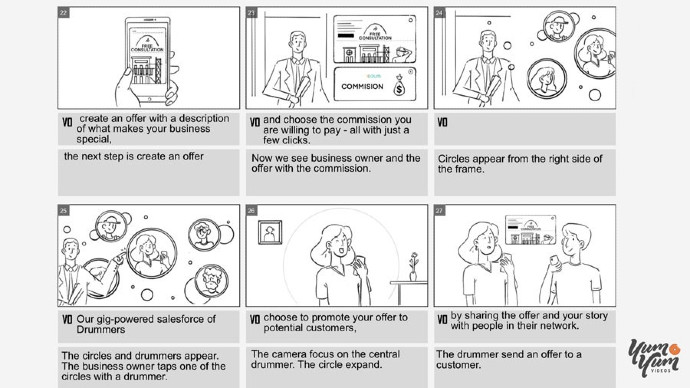How to Make Product Videos That Actually Drive Sales

Product videos are one of the most compelling types of marketing content for showing audiences what you're offering—not just a product or service, but a solution to their problems. When done right, they are amazing at prompting potential customers into closing a sale. Particularly when you're dealing with B2B prospects and clients, product videos provide a direct and effective form of communication that can speed up the decision-making process.
If you do them right.
As the best video production companies out there will tell you, there's more to it than just describing your product's features and calling it a day. You need to focus on sparking interest among your prospects.
In this article, I'm going to walk you through the essentials of making awesome product videos that deliver results. I'll show you how to choose the right type of product video (yes, there's more than just one), how to polish your script, and what options you have to promote your competed masterpiece.
See you on the action-field,
Raksha Sukhia, SMB Growth Expert,
Founder BBR Network. #bbrnetwork
Showcasing Your Product's Key Value Propositions to Your Audience
One of the most common mistakes of most failing marketing efforts is the inability to explain the product in a way that fits the target audience's perception. Yet, figuring out what your product's value proposition is should come way before planning the specifics of any marketing strategy.
Take the time to understand what your potential customer's needs are and how your product satisfies them.
After all, nothing sounds as impossible as trying to sell something you don't fully understand, to an audience you don't know.
So, before you even begin to think about your video, you need to be able to answer the following two questions. Try to be as specific as you can when gathering the information you need to answer them; that information will determine the positioning of your product video and your overall marketing strategy.
Question 1: What are your potential clients interested in?
Each company has a distinguishable culture and identity, with specific needs: You might say every B2B client is, like an individual, unique in its own way. So, your video should as if you're talking directly to them—addressing their specific preferences and interests.
Sure, you may think that in a business environment everybody just wants to either save money or make more of it. But B2B clients also value efficiency and trust—among other concerns.
So, dig deeper into your ideal client's mind. If you understand what your audience wants, you'll be more likely to know how to compose a video that appeals to them.
Question 2: How do your products or services make work easier for them?
Consumer make impulse decisions when shopping, but B2B buyers have established purchase processes that include weighing all kinds of considerations and involving multiple stakeholders.
In today's digital world, your message needs to be honest and transparent. Your audiences want and need to know exactly how the product or service you're offering will benefit their business.
Your message will stick with them insofar as it addresses their interests and problems. Does your product make everyday tasks easier for them? Will they be able to drive revenue faster? Why is your service better than your competitors?
Choosing the Right Type of Product Video
Specific kinds of product videos best fit specific marketing needs. Let's talk a bit about what the three most popular types are and how to get them right.
1. Product Demos
This is your classic product video, the one that showcases how your product looks and what its key benefits are. Good demos should also show the product in action, to give audiences a clear idea of how it works.
Product demos are the most traditional form of marketing videos, but there are things you can do to can spice things up and illustrate your product in creative ways. In other words, don't stay at the level of simply description!
2. Explainer Videos
As I've noted, you're selling more than just an object: Your product or service aims to solve a problem. And there are few tools as effective as explainer videos to explain that to an audience.
These videos use all sorts of resources—storytelling, whiteboard animation, motion graphics, and sound design—to show exactly how your clients can benefit from your product.
Following a simple two-act structure, explainers begin by introducing a relatable character with an issue, then showing how your product solves that problem.
3. Customer Testimonials
If you're looking to show the value of your product by way of example and illustration, go with a customer testimonial. These types of videos often take the form of interviews with your most satisfied customers about how your product or service benefited their company.
Empathy plays an essential part in effective storytelling, and testimonials are all about letting your happy clients do the convincing for you. There's a reason user reviews are so popular: people trust people who are like them or who are in similar circumstances.
Perfecting the Foundations: Script and Storyboard
Once you have an idea about the type of video you're going to make, it's time to start scripting! Here are a few tips to guide you along the way.
1. Start with a script—always
The script is the backbone of every successful video. If you develop and polish your script before moving on to other tasks, you'll save yourself plenty of headaches during production.
If you have your message set down clearly on paper, your video will unfold from there.
2. Keep it short and simple
Your script will set the tone and approximate length of your video. Of course, you'll probably start with a long outline of your ideas, but sooner rather than later you'll start editing and cutting.
As a general rule, keep your script short and simple: Nobody wants to sit through a long and complex piece!
3. End with a CTA
Always include a call to action on your message, with clear instructions on where your clients can find out more about your company or how they can get in touch with a sales representative.
4. Create a storyboard
A storyboard is a great way of getting a clear idea of how you want your video to look—and even discovering contradictions you hadn't noticed on your script.
There's no need to illustrate every scene, but drawing the key moments of your script is a useful technique.

Promoting Your Finished Product Video
Once you've made the final cut of your video, it's time to get your audience to watch it. So, where can you upload your piece? Here are a few ideas.
Landing Page
Product videos fit perfectly on company websites, where interested customers can easily find them. If you're going to embed your video on your landing page, make it the centerpiece. You can place it in the top-center space and arrange your other content around it.
Social Media
Social media has become the end-all and be-all of branded content for a reason. Upload your video on the platforms you know your targeted audience uses and consider promoting your content to get more leads. Plus, you can adapt your content to each specific platform and upload natively to enhance engagement.
Direct Marketing
You can use your video as part of your direct marketing strategy, embedding your piece in your newsletter or in other forms of messaging. Most audiences aren't expecting an engaging video like yours in their mailbox, so you'll be noticed!
* * *
An effective product video can speak directly to your B2B clients and attract their attention.
But it's important to remember that these tips aren't written in stone.
Your video should be a mutable project that adapts to your strategy needs and the profiles of businesses you are appealing to.
SignUp for Weekly Ezine
Related Article
What’s a Good Landing Page Conversion Rate?
Business Agility Is the New Norm. Do You Have What It Takes?
Tags
#BBR Network, #Profitability, #Small Business Growth, #Small Business Marketing and Sales, #SMB, #SME, ahrefs outreach, B2B, backlink strategy, benefit of sem, Build Business Results, Build Business Results (BBR), Build Business Results (BBR) Mastermind., Build Business Results (BBR) Network Business Advisory, Business Tips, content based link










